In the context of The Milk of Dreams – Venice Biennale 2022, at the arsenal, the section Time Capsule ferries ideologies and practices between the 20th and the new millennium following a surrealist line that further projects into the future through a reflection on the posthuman era. On the one hand, the exhibition format favors an evolutionary path over the traditional historical-critical method which, in questioning the identity of humans nowadays, highlights anachronisms and alliances in terms of heterogeneity and multiplicity. On the other hand, the surrealist line of the exhibition suggests a reflection on the metamorphosis of bodies in relation to modern technologies. All in all, the feminist posture of the exhibition, commissioned by the curator Cecilia Alemani, gives evidence to a gradual dissolution of formalist languages to favor material, technical and digital experimentation in a horizontal and inclusive manner.
Among the most significant present works, the great bronze totemic figure by the American artist Simone Leigh, Brick House, seems to impose a new futuristic order. Not only eloquently representing the African diaspora, this arcane and silent woman induces a sense of spirituality and reverence which, together with the sculptural complex in the American Pavilion, earned the artist the Golden Lion as Best Participant in the 2022 Biennale. The reflection on the central role of women in families and community contexts is also central to the works of the Argentine artist Gabriel Chailein, who presents a complex of five oven-sculptures that portrays some members of the artist’s family through an anthropomorphic vision, such as in Rosario Liendro where, through the reinterpretation of indigenous archetypes, the artist reveals his personal theory of form.
From the complex postcolonial reality of Cape Town, Igshaan Adams presents a large tapestry where pictorial techniques and local manufacturing converge, and in which that so called “lines of desire” stand out, a term used by the artist in order to indicate secondary routes drawn at the time of Apartheid, here emphasized by geometric patterns and further compared with a wire installation inspired by the ethereal clouds of dust created by the indigenous riel dance of the Northern Cape province. From Haiti, the tapestries by Myrlande Constant, Sirenes and Guede, revisit the motifs of indigenous sacred art through an appropriation of the manufacturing technique of drapo Vodou, to indicate processes of transmutation of the human body into animal, vegetable, and hybrid forms through the use of vivid colors and fluid lines, that here becomes a representation of vitality and joy. The process of gradual dissolution of the form is present in the paintings on canvas by the British artist Emma Talbot who, already awarded the Max Mara Prize for Women, presents the work Where Do We Come From, What Are We, Where Are We Going? Such as a vision of a post-anthropocentric and posthuman reality. With a reference to Gauguin, the simplified figures, the mythological motifs, the rhythmic patterns, the bright colors and the calligraphic texts composed by the artist converge in her tapestries to suggest how through the feminine, we can think of a reunion with nature in a sustainable key.
Following an archival parenthesis aimed at certifying the contributions made in the 1900s towards such an evolutionary turn, the exhibition resumes in a posthuman and futuristic key. The video-installations of the Georgian artist Andro Eradze seem to answer the call for posthuman considerations. With Raised in the dust, the artist takes up the poetic poem Eater of snakesby the poet Vazha-Pshavela through the posthuman lens of Donna Haraway to question the difference between the laws of nature and social norms. Along the same lines, from Canada, Jes Fan, with the glass sculptural complex Systems II, explores the depths of biological life through an animistic approach that explores the correlation between body and technology in terms of scientific experimentation and plasticity. Similarly, the biomorphic sculptures of the French artist Marguerite Humeau are sinuous sculptures composed of materials such as aluminum, salt, plastic waste found in the ocean and algae, and they stand out for their sophisticated technical experimentation. As in a dance, they celebrate the modern sublime, revisiting the possible relationships between fossils and cyborgs according to the codes of hypermodern technology and medicine.
These artistic researches seem to converge around the practice of Barbara Kruger such as a homage to the career and feminist commitment of the American artist who since the 70s is known for her installations and videos and for her use of black and white photos traced by graphic signs and superimposed on red or black bands, now an iconic scheme of her. For the Biennale the artist proposes a site-specific installation in which a message stands out: “Please care, Please mourn”, resonating as a futuristic statement aimed to support an ethic way of living.
Leaving the experience of the exhibition, one encounters the complex of suspended sculptures Dance Dead, by the Italian artist Giulia Cenci, already awarded the MAXXI Bulgari Prize 2020. After a deep lesson in the anatomy of human bodies, animals, and plants, for realizing this artwork, the artist retrieves everyday objects and modelled elements in order to explore the themes of technology and nature in an alchemical assembly process. Without orders or linear paths, Time Capsule is an evolutionary journey that arises as a necessity, giving evidence to curious and intelligent mind of artists in the post-pandemic phase of this new millennium.
Sara Buoso
Info:
various artists, The Milk of Dreams
directed and curated by Cecilia Alemani
23/04/2022 – 27/11/2022
Venice Biennale 2022
Arsenale and Giardini
Venice
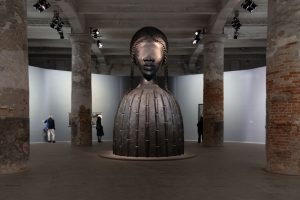 Simone Leigh, Brick House, 2019, bronzo. La Biennale di Venezia, The Milk of Dreams. Ph Roberto Marossi, courtesy La Biennale di Venezia
Simone Leigh, Brick House, 2019, bronzo. La Biennale di Venezia, The Milk of Dreams. Ph Roberto Marossi, courtesy La Biennale di Venezia
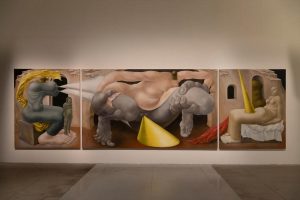 Louise Bonnet, Pisser Triptych, 2021-22, olio su lino, trittico di dimensioni variabili. Ph Roberto Marossi, courtesy La Biennale di Venezia e Gagosian
Louise Bonnet, Pisser Triptych, 2021-22, olio su lino, trittico di dimensioni variabili. Ph Roberto Marossi, courtesy La Biennale di Venezia e Gagosian
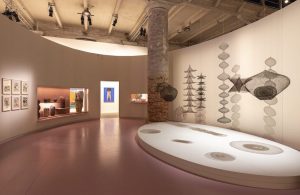 Capsula – Una foglia una zucca un guscio una rete una borsa una tracolla una bisaccia una bottiglia una pentola una scatola un contenitore / A Leaf a Gourd a Shell a Net a Bag a Sling a Sack a Bottle a Pot a Box a Container, 2022, installation view. Ph Roberto Marossi, courtesy La Biennale di Venezia
Capsula – Una foglia una zucca un guscio una rete una borsa una tracolla una bisaccia una bottiglia una pentola una scatola un contenitore / A Leaf a Gourd a Shell a Net a Bag a Sling a Sack a Bottle a Pot a Box a Container, 2022, installation view. Ph Roberto Marossi, courtesy La Biennale di Venezia
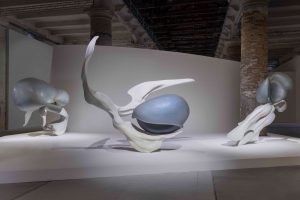 Migrations (El Niño, Kuroshio, La Niña), installation view, Ph Roberto Marossi, courtesy La Biennale di Venezia, l’artista, CLEARING, White Cube
Migrations (El Niño, Kuroshio, La Niña), installation view, Ph Roberto Marossi, courtesy La Biennale di Venezia, l’artista, CLEARING, White Cube
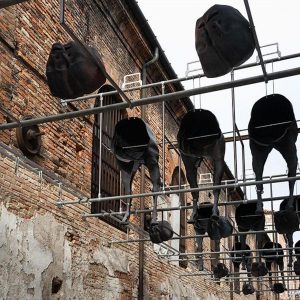 Giulia Cenci, Dead Dance, 2022. Ph Roberto Marossi, courtesy La Biennale di Venezia, Illy Art Collection 2022
Giulia Cenci, Dead Dance, 2022. Ph Roberto Marossi, courtesy La Biennale di Venezia, Illy Art Collection 2022

She is interested in the visual, verbal and textual aspects of the Modern Contemporary Arts. From historical-artistic studies at the Cà Foscari University, Venice, she has specialized in teaching and curatorial practice at the IED, Rome, and Christie’s London. The field of her research activity focuses on the theme of Light from the 1950s to current times, ontologically considering artistic, phenomenological and visual innovation aspects.






NO COMMENT